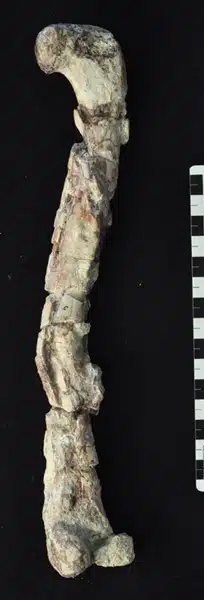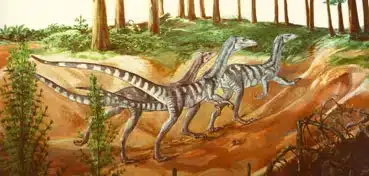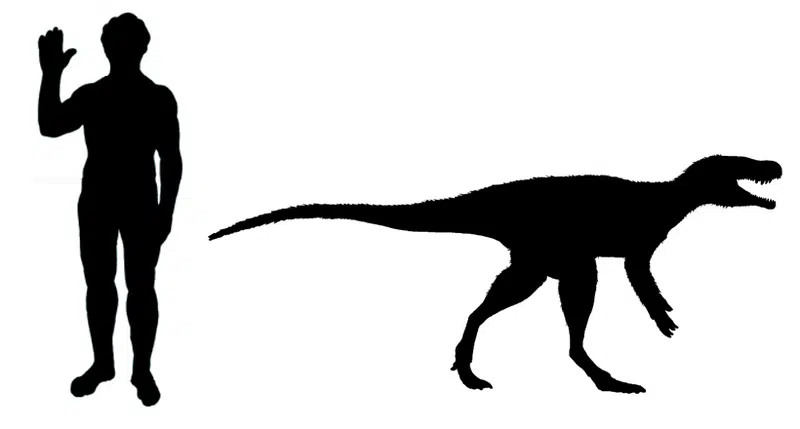Delving into the prehistoric world often brings us face to face with creatures that defy our modern understanding of life on Earth. Among these ancient marvels is Chindesaurus, a dinosaur whose very name conjures images of a bygone era. This early dinosaur, known as the ‘Ghost Lizard’, hails from a period shrouded in mystery and fascination – the Late Triassic. Let’s embark on a journey to uncover the secrets of this enigmatic creature.
Originating from the rugged terrains of what is now Arizona, Chindesaurus provides a fascinating glimpse into life at the dawn of the dinosaurian era. Its discovery in the Petrified Forest National Park not only enriches our understanding of early dinosaur evolution and diversity, but also paints a vivid picture of the prehistoric landscapes of North America.
Chindesaurus Key Facts
| Keyword | Fact |
|---|---|
| Pronunciation | CHIN-diss-OR-us |
| Meaning of name | Chinde Point Dinosaur / Ghost Lizard |
| Group | Theropod or basal Saurischian |
| Type Species | Chindesaurus bryansmalli |
| Diet | Carnivore |
| When it Lived | 228.0 to 208.5 MYA |
| Period | Late Triassic |
| Epoch | Norian |
| Length | 6.0 to 7.0 feet |
| Height | Approximately 3.0 feet at the hip |
| Weight | Approximately 50.0 to 100.0 pounds |
| Mobility | Moved on two legs |
| First Discovery | 1984 by Bryan Small |
| Described by | 1995 by Robert Long and Philip Murry |
| Holotype | PEFO 10395 |
| Location of first find | Chinle Formation, Petrified Forest National Park, Arizona |
| Also found in | New Mexico |
Chindesaurus Origins, Taxonomy and Timeline
The name ‘Chindesaurus’, blending the Navajo word for ghost (chindi) with the Greek sauros for lizard, is as evocative as the dinosaur itself. This nomenclature not only highlights the dinosaur’s haunting presence in our imagination but also pays homage to the indigenous culture of its discovery region.

Placing where exactly Chindesaurus sits in the dinosaur family tree (determining its phylogenetic relationships in technical parlance) has proved particularly difficult. This is because it existed at a time when dinosaurs as a group were only just beginning to diversify, meaning they had yet to acquire the various distinguishing characteristics that makes it possible to tell one lineage apart from the other. So, in the dinosaurian world of Chindesaurus, telling a burgeoning plant eater apart from a burgeoning carnivore is far from easy – especially when you only have fragmentary material to work from! While Chindesaurus is generally thought to represent an early member of the carnivorous theropod clade, many scientists argue for a position at the very base of the saurischian dinosaur branch – that is, prior to the split between the plant eating Sauropodomorphs and Theropoda.
The timeline of Chindesaurus spans the Norian Epoch of the Late Triassic Period, dating back an astonishing 228.0 to 208.5 million years ago. This era marks a critical juncture in Earth’s history, setting the stage for the rise of the majestic creatures that would go on to dominate the rest of Mesozoic Earth over the ensuing 140 million years of the Jurassic and Cretaceous Periods.
Discovery & Fossil Evidence
The tale of Chindesaurus’s discovery begins in 1984, when Bryan Small first unearthed this ancient predator in the Chinle Formation of Arizona. This was a significant find for the Petrified Forest National Park, with the discovery of “Gertie”, as the fossil affectionately came to be called, still celebrated annually within the park.

U.S. National Park Service, Public domain, via Wikimedia Commons
Later explorations revealed that this dino was not exclusive to Arizona. Fossil evidence also emerged from the soils of New Mexico, suggesting a range that spanned most of the American southwest. These findings include fossilized bones, each a puzzle piece in reconstructing this creature’s life story.
The preservation of these fossils varies, with some specimens providing clearer insights than others. Notably, the holotype, PEFO 10395, stands as a critical reference point, anchoring our understanding of this dinosaur’s physical form.
Chindesaurus Size and Description
Venturing back millions of years, the figure of Chindesaurus emerges from the mists of time, a fascinating chapter in the narrative of Earth’s ancient inhabitants. Let us paint a picture of this remarkable basal dino, piecing together its physical attributes from the fragments left behind.
Short description of Chindesaurus
Reconstructions of Chindesaurus have been hampered by the fragmentary nature of its preserved remains. Originally reconstructed with a robust build similar to the hypercarnivorous Herrerasaurids that also shared its world, later interpretations have favoured a more sleek, gracile build with long, powerful legs, suggesting a capability for significant speed and agility. Its neck was fairly long, contributing to a striking profile and possibly aiding in foraging or hunting. While details about its skin remain elusive, it’s likely that it shared characteristics common to most early dinosaurs, such as a scaly texture, although many scientists wonder if even at this stage the earliest proto-theropods were already sporting the filamentous fluff that would later evolve into feathers. Regarding locomotion, this creature was undoubtedly bipedal, navigating its world on two sturdy legs.
Size and Weight of Type Species
The size of Chindesaurus has been a topic of debate among paleontologists, leading to a range of estimates. Long and Murry envisioned it as a fairly large dinosaur, with a length ranging at about 9.9 to 13.1 feet. This estimation paints the image of a formidable predator, striding confidently across the Triassic landscape.
In contrast, Benson and Brusatte in 2012 posited a smaller stature for Chindesaurus, suggesting a sportier length of 6.6 to 7.5 feet. Adding to this spectrum of estimates, Holtz in 2012 compared Chindesaurus to the size of a modern wolf, with an estimated length of about 6.6 feet and a weight ranging from 50.0 to 100.0 pounds. These varying assessments reflect the ongoing quest to fully understand the dimensions of this ancient creature.
Given these divergent views, an average estimate would place Chindesaurus at a length of approximately 6.0 to 9.0 feet and a weight akin to that of a large wolf. It’s important to note, however, that the skeletal anatomy of Chindesaurus is incompletely known, making these estimates rough approximations at best. The holotype specimen’s features, such as unfused ankle bones and vertebral neurocentral sutures, indicate it may not have been fully grown, adding another layer of complexity to our understanding of its true size.
The Dinosaur in Detail
The vertebral column of Chindesaurus provides insight into the development of key anatomical traits within early branching dinos. Its cervical vertebrae, positioned near the head, possessed a low keel and a pair of shallow, oval-shaped depressions on their sides. These latter structures likely represented pneumatized precursors of the deep invasive hollows of later theropod dinosaurs – a bone-lightening adaptation that would prove particularly useful when the first theropods began experimenting with flight fifty million years later. The dorsal vertebrae, on the other hand, were deep, wide, and fairly short, a trait closer to Herrerasaurids than to true theropods like Tawa. These adaptations possibly aided in supporting a sturdy and muscular trunk, essential for the demands of an active predatory lifestyle.
The sacral and caudal regions of Chindesaurus further underline its distinctiveness. The sacral vertebrae, not fused to each other, suggest a flexibility in the hip region, perhaps lending agility to this dinosaur. The large sacral ribs, with their unique cross-sectional shape, hint at a robust structure, supporting the body’s weight and facilitating locomotion. The caudal vertebrae, transitioning from large at the base to elongated towards the tip, indicate a tail that was both powerful and maneuverable. This tail design, complete with distinctive neural spines and chevrons, could have been crucial for balance and perhaps even communication through visual displays.
Intriguing Anatomy of limbs
The limb anatomy of Chindesaurus is equally intriguing. Its femur, long and sigmoid, echoes the traits seen in dinosaurs like Tawa. The lower end of the femur, with its triangular condyles, implies a strong and stable connection to the lower leg, essential for a bipedal predator. The tibia, sharing characteristics with Tawa and other early dinosaurs, supports the idea of a swift and agile hunter. The unique structure of the astragalus, especially its ‘glutealiform’ shape and ascending process, speaks to a complex and efficient foot structure, critical for movement in diverse terrains.
Contemporary Dinosaurs

Tawa, a fellow maybe-theropod, roamed these ancient plains alongside Chindesaurus. Sleek and possibly more agile, Tawa might have been a competitor for resources. Imagine the tension-filled encounters over territory or prey, a dance of dominance and survival where agility and cunning were as crucial as brute strength. Tawa, possibly more swift but smaller, could have forced Chindesaurus to adapt its hunting strategies, making it a more versatile predator in the process.
Gojirasaurus, the largest theropod of its day, was likely at the top of the food chain. This enormous predator, towering over Chindesaurus, might have posed a significant threat, either as a competitor or a potential predator. The interactions between Gojirasaurus and Chindesaurus, whether as adversaries or mere co-inhabitants of the same territory, would have been a compelling display of ancient animal behavior, a testament to the survival of the fittest.
Camposaurus, sharing the environment with Chindesaurus, could have been both a competitor and a complement in the ecosystem. Though their interactions remain shrouded in the mysteries of time, it’s not hard to envision a scenario where these two dinosaurs might have had to strategize for survival, whether through competition or avoidance. Camposaurus, similar in size to Chindesaurus, would have made a formidable competitor, constantly pushing Chindesaurus to adapt and evolve.
Caseosaurus, on the other hand, was likely less of a direct competitor to Chindesaurus but still an integral part of the same ecological web. Their coexistence is a reminder of the diversity of life during this era, where each species had its role, its niche, its unique way of navigating the challenges of a world dominated by these magnificent creatures.
Interesting Points about Chindesaurus
- Chindesaurus’s name, blending Navajo and Greek, reflects a fusion of cultures and science.
- It lived in the Norian Epoch, a critical time for dinosaur evolution.
- The discovery of Chindesaurus in Arizona and New Mexico suggests a wider habitat range.
- Its carnivorous nature implies a position as a predator in its ecosystem.
- The lack of complete fossil records invites ongoing exploration and study.
Chindesaurus in its Natural Habitat
The world of Chindesaurus was vastly different from ours today, with the supercontinent Pangea only just beginning to break into the constituent continents that we recognise today. The Late Triassic climate, characterized by variable conditions, shaped a landscape teeming with diverse flora and fauna. This dino navigated a terrain marked by both challenges and opportunities.
As a carnivore, Chindesaurus was likely an active hunter, relying on its agility and keen senses to track down prey. Its role in the food chain would have been crucial, impacting the population dynamics of its contemporaries.
The social behavior of Chindesaurus is a subject of speculation. Did it hunt in packs or stalk its prey alone? These questions fuel our curiosity about the daily life of this ancient predator.
Frequently Asked Questions
The name combines a Navajo word meaning ‘ghost’ and the Greek word for ‘lizard.’
It roamed the Earth during the Norian Epoch of the Late Triassic Period, about 228.0 to 208.5 million years ago.
A very early one. Although in general aspect it most closely resembled a theropod, the mainly carnivorous branch of dinos.
It was first unearthed in the Chinle Formation of Petrified Forest National Park, Arizona.
It was carnivorous, likely preying on other animals of its time.
Yes, fossils have also been discovered in New Mexico.
Sources
The information in this article is based on various sources, drawing on scientific research, fossil evidence, and expert analysis. The aim is to provide a comprehensive and accurate overview of Chindesaurus. However, please be aware that our understanding of dinosaurs and their world is constantly evolving as new discoveries are made.
- https://paleolab.com.br/assets/uploads/files/%28103%29_Marsh_et_al._2019.pdf
- https://books.google.gr/books?id=wbv9CQAAQBAJ&printsec=frontcover&source=gbs_ge_summary_r&cad=0#v=onepage&q&f=false
- https://www.researchgate.net/publication/6197829_A_Late_Triassic_Dinosauromorph_Assemblage_from_New_Mexico_and_the_Rise_of_Dinosaurs
This article was last fact checked: Joey Arboleda, 03-12-2024
Featured Image Credit: Jeff Martz, CC0, via Wikimedia Commons

